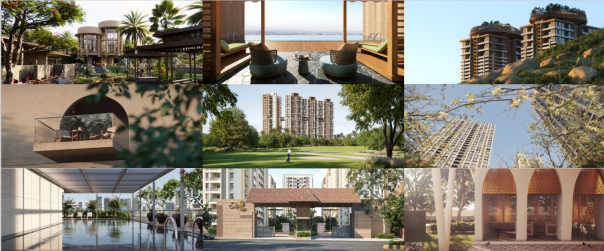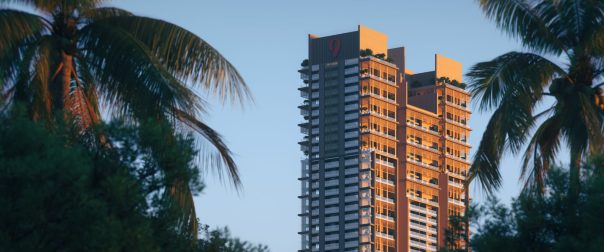
Impact Design Studio was established in 2010 in Ahmedabad, India, by two young brothers in the archviz industry. After sharing their widely acclaimed project, ANUTHAM, they achieved a great deal of recognition from the general public and the Chaos Corona forum. This recognition served as a turning point for the studio, propelling them to consistently strive for excellence in the years ahead.
We sat down with Manji Vagjiyani, the owner of Impact Design Studio, who gave us insight into the studio’s values, their approach to collaboration, helpful tips on creating powerful visual storytelling, and a breakdown of one of their latest villa projects rendered in Chaos Corona. Read on to learn more about the innovative work of Impact Design in the field of archviz.

The influence of Indian culture
Indian culture and philosophy have deeply influenced Impact Design Studio’s creations. The studio draws inspiration from the vibrant colors, spiritual motifs, and fusion of tradition and modernity found in Indian architecture. This results in visually rich representations that showcase the timeless beauty and cultural significance of India’s culture in the digital realm. From recreating historic monuments to futuristic designs rooted in ancient principles, the studio relies on CGI to seamlessly blend tradition with technology.
Capturing an emotional connection
Apart from striving for hyperrealism, Impact Design Studio focuses on conveying a strong narrative that engages the viewer and draws them into the space they’ve visualized. Sometimes, that narrative centers around the client’s own experience. Their client for Visaaya had a profound emotional connection with the architectural space featured in the film. This emotional bond then served as the centerpiece of the narrative. The primary objective in crafting the film was to genuinely capture and communicate the client’s deep sentiments towards that unique location. A meticulous approach was taken, with the aim of creating a visually stunning experience complemented by a captivating background score, all working together to capture the true essence of this emotional connection.
Collaborating with architects and engineers
Each architect and project the studio has collaborated with brings a unique aesthetic sense and vision, fostering an environment of innovation and experimentation. This diversity within the collaborations allows the studio to push the boundaries of their VFX and 3D presentation techniques, leveraging advancements in software and technology.
Balancing artistic vision with engineering needs in architecture and design is also crucial. For Impact Design, it is important to involve engineers early in the process, fostering collaboration and considering cost-effective solutions without compromising the design essence.
Prototyping helps with tackling intricate designs, and flexibility should be maintained throughout, with decisions being well-documented, risks managed, and continuous feedback maintained. Impact Design shares that the success of a project relies on seamless teamwork and collaboration, where creativity and engineering excellence come together harmoniously.

The key to powerful visual storytelling
For young artists, maintaining unwavering focus and cultivating a clear mindset is crucial to achieving their goals. By transforming a client’s emotional connection into a cinematic masterpiece, artists can create an immersive and emotionally resonant experience for the viewer. As explained by Impact Design Studio, the ultimate goal is to convey deep feelings evoked by the surrounding space – exploring every corner and detail so that viewers feel deeply moved by the outcome and understand the message of the story.
The necessary elements
When working on archviz films, Impact Design shares that the following elements are essential for creating powerful visual storytelling.
- Excellent camera work: Capture stunning visuals with finesse to showcase the intricacies of the design.
- Thoughtful camera strategy: Enhance the story by highlighting key features of the space and by creating an immersive experience.
- Captivating background music: Let the music serve as the heartbeat of the narrative, connecting viewers emotionally to the visuals.
- Strive for harmony in postproduction: Achieve a unison of exceptional visuals, elegant camera work, and music finely edited to elevate the architectural story and create a memorable cinematic experience. Try not to pay too much detail to one element so it overpowers the others – it’s a balancing act.
Tips for achieving technical expertise
Impact Design Studio shares the following tips that can help develop an artist’s technical expertise and transform their architectural ideas into captivating and memorable visual narratives.
- Understand the design: Grasp the vibe, purpose, and function of the architecture.
- Pay attention to the details: Focus on lighting, textures, and realism.
- Try dynamic camera moves: Add excitement and engage the audience.
- Utilize natural light and weather conditions: Set the right mood and add variety.
- Craft a relatable story: Showcase the functionalities of the objects or the daily use of the space so the viewer pictures themself in the space.
- Add animated humans: Provide scale and bring the environment to life.
- Incorporate sound: Include footsteps, birds, or machinery sounds for an immersive experience.
- Collaborate with architects: Ensure accurate visuals by working closely with professionals who have architectural training.
- Optimize for performance: Make necessary adjustments to the frame rate, scale, and size of your project and optimize the film’s performance for the device and platform the audience will view it on.
Tackling tight deadlines
The concept of a deadline holds great importance in every professional field. For Impact Design, this was particularly the case while working on IRIS. The team faced the challenge of a looming deadline, which required them to work diligently within a very limited time frame. Their relationship with the deadline, however, was unique. Rather than viewing it as a source of stress, they saw it as a motivator that boosted their efficiency and creativity. Despite the difficulties that come with tight deadlines, the team was able to find a balance and turn the pressure into an ally. This ally helped them navigate obstacles and stay focused on their goal.
3D animation breakdown: Making of Sukhdham
Sukhdham aimed to celebrate space by creating a contemporary villa with elaborate architecture. The project took approximately two months, including modeling, images, and animation.
When working on the initial composition, the camera angle played a crucial role in shaping the viewer’s perception of the shots and frames. The team often used leading lines to guide the viewer’s eye. They also used storyboarding to clarify their vision and determine the sequential path of the film.
Moving on to the modeling process, they built the entire model in SketchUp. Afterward, they imported it into 3ds Max and refined the details.
Background music played a significant role in creating the desired mood and enhancing the visualization experience. They searched for a piece of music that could perfectly match the animation and give the feeling of a dramatic mood.
Textures and materials were given special attention as they play an important role in any animation. With the use of Chaos Corona, their focus was to make every surface texture and material feel as naturally realistic as possible.
When it came to landscaping, they simply followed the type of landscaping that was chosen by their client. Similarly, for scattering objects, they used Forest Pack, which allowed them to achieve high-quality scattering with a natural feel by experimenting with different attributes.
Simulations were used to make natural elements, such as water and trees, look alive and realistic.
Lighting played a crucial role in setting the ambiance of each scene. Throughout the animation, they captured certain times of day, such as early morning, early evening, and a moonlit night to give the viewer a better idea of how the architectural space changes under different lighting conditions.
Lastly, camera animations were used to effectively demonstrate the architectural space’s connection with different indoor and outdoor areas. During camera compositions, they kept the rule of thirds, leading lines, and depth of field in mind to guide their viewers effectively.
Leveraging Chaos Corona’s standout features
Corona Render’s standout feature is its speed—a game-changer, especially in extensive projects like La Perque. Given the project’s vast landscapes and intricate details, prioritizing large-scale development is essential. The remarkable swiftness of the Corona Renderer is instrumental in this context. It liberates time that would otherwise be consumed by the demanding pursuit of achieving quality and optimal effects. This newfound time allows us to shift our focus towards meticulous detailing, providing the opportunity to refine and enhance the intricacies of the project. Rather than grappling with time constraints, we can invest effort where it matters most, ensuring a comprehensive and polished outcome for La Perque and similar ambitious endeavors.
The speed is a game-changer in the workflow — essential for handling big projects efficiently. The short workflow is a blessing, freeing up time to focus on the details we’re passionate about and taking the stress out of creating a high-quality rendering. The multi-region capability is another gem, offering flexibility in honing in on specific areas. Then there’s Lightmix, a handy tool for fine-tuning lighting elements. Finally, the ease and speed with which you can achieve beautiful caustics adds an extra element of wonder to your renders. Together, these features make Chaos Corona a go-to for creating stunning visuals without the headache.
Manji Vagjiyani, owner, impact design studio
Fantastic insights in this article! Thanks for sharing these valuable tips and experiences.